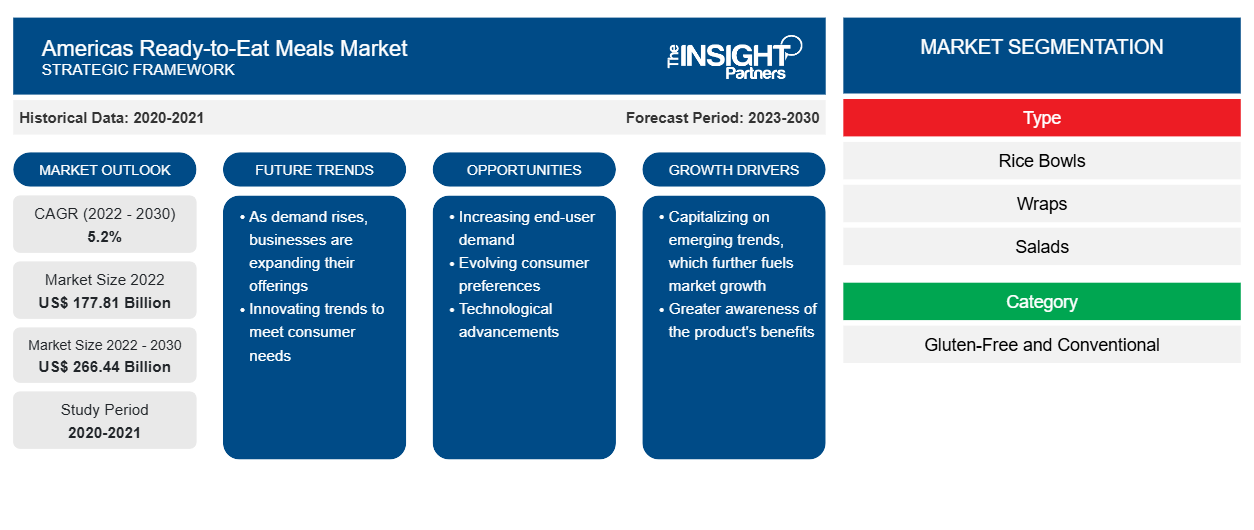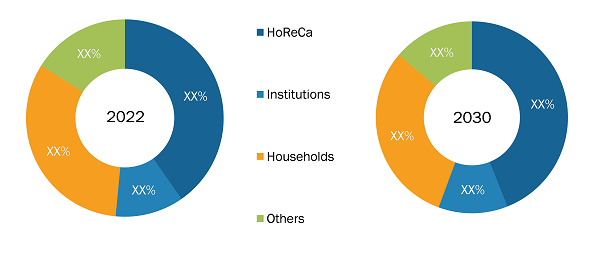Americas ready-to-eat meals market is expected to grow from US$ 177.81 billion in 2022 to US$ 266.44 billion by 2030. It is expected to grow at a CAGR of 5.2% from 2022 to 2030.
MARKET ANALYSIS
Ready-to-eat meals are precooked and packaged food products with prolonged shelf life. Sandwiches, wraps, pizzas, burgers, pasta and noodles, curries and gravies, burritos, and rice bowls are a few of the widely consumed ready-to-eat meals. Convenience food such as ready-to-eat and ready-to-cook products allows consumers to save time and effort associated with ingredient shopping, meal preparation, cooking, consumption, and post-meal activities. The efforts and time saved on food preparation and its storage and transport convenience further drive the ready-to-eat meals market.
GROWTH DRIVERS AND CHALLENGES
Rising sales of ready-to-eat meals through online channels and availability of products as per changing consumer preferences across the Americas have aided the market growth of ready-to-eat meal products. The rising penetration of the internet and smartphones, quick access to emerging technologies, rising purchasing power, and convenience provided by online retail shopping platforms are among the key factors bolstering e-commerce. People are increasingly preferring online retail channels for buying ready-to-eat meals. The online sales of food and beverages grew significantly during the COVID-19 outbreak due to the shutdown of brick-and-mortar stores and the imposition of several social restrictions by governments of various countries across the globe. According to the “2020 Food and Health Survey” of 1,011 Americans (aged between 18 to 80 years) conducted by the International Food Information Council in 2020, 33% of consumers shopped for food products online, indicating an increase in online shopping compared to 27% in 2019. Consumers are increasingly seeking healthy, nutritious food options, which has surged the demand for healthy alternatives to conventional foods such as vegan, gluten-free, lactose-free, high-fiber, high-protein, or low-calorie ready-to-eat meals. Growing demand for healthy food has prompted manufacturers to develop and expand product portfolios according to specific customer requirements. The risk of contamination in ready-to-eat meals poses a challenge to the Americas ready-to-eat meals market. The ready-to-eat meals pose potential contamination risks due to improper hygiene practices and inadequate storage. Supply chain issues, including transportation and packaging, can also contribute to contamination risks. Foodborne pathogens, including Escherichia coli, Listeria monocytogenes, and Salmonella spp, are major contamination concerns in refrigerated ready-to-eat meals. However, stringent quality control and adherence to food safety regulations can help to mitigate potential contamination risks and ensure the safety of ready-to-eat meals for consumers.
Customize This Report To Suit Your Requirement
You will get customization on any report - free of charge - including parts of this report, or country-level analysis, Excel Data pack, as well as avail great offers and discounts for start-ups & universities
Americas Ready-to-Eat Meals Market: Strategic Insights

-
Get Top Key Market Trends of this report.This FREE sample will include data analysis, ranging from market trends to estimates and forecasts.
REPORT SEGMENTATION AND SCOPE
The "Americas Ready-to-Eat Meals Market Analysis to 2030" is a specialized and in-depth study with a major focus on the Americas market trends and growth opportunities. The report aims to provide an overview of the Americas market with detailed market segmentation on the basis of type, category, end user, and geography. The Americas ready-to-eat meals market has been witnessing high growth over the recent past and is expected to continue this trend during the forecast period. The report provides key statistics on the consumption of ready-to-eat meals in the Americas and their demand in major countries. In addition, the report provides a qualitative assessment of various factors affecting the ready-to-eat meals market’s performance in major regions and countries. The report also includes a comprehensive analysis of the leading players in the ready-to-eat meals market and their key strategic developments. Several analyses on the market dynamics are also included to help identify the key driving factors, market trends, and lucrative opportunities that would, in turn, aid in identifying the major revenue pockets.
Further, ecosystem analysis and Porter’s five forces analysis provide a 360-degree view of the Americas ready-to-eat meals market, which helps understand the entire supply chain and various factors affecting the market growth.
- This FREE sample will include data analysis, ranging from market trends to estimates and forecasts.
SEGMENTAL ANALYSIS
The Americas ready-to-eat meals market is segmented on the basis of type, category, and end user. Based on type, the ready-to-eat meals market is segmented as rice bowls, wraps, salads, burritos, gravies and curries, noodles and pasta, pizza, soups and stews, meat entrees, burgers, sandwiches, and others. On the basis of category, the market is bifurcated into gluten-free and conventional. The ready-to-eat meals market is categorized, based on end user, into HoReCa, institutions, households, and others. In the type segment, the noodles and pasta segment accounted for a significant share in the market. Ready-to-eat noodles and pasta are served in single-serving containers, making portion control and reheating easier. Changing food consumption habits, busy lifestyles, exposure to diverse cultures, and increased demand for varied cuisine and convenience food are key factors driving the demand for ready-to-eat noodles. Manufacturers launch ready-to-eat noodles and pasta in several categories, such as vegan, gluten-free, or organic, making it a more convenient meal option. In terms of end user, the HoReCa segment accounted for the highest market share. HoReCa includes hotels, cafes, restaurants, and bars, generally providing a wide range of cuisines and a diversified menu of food and beverages. Ready-to-eat meals are served in institution canteens, catering to large groups. Institutions offer diverse ready-to-eat meals, including breakfast, lunch, and dinner. The household segment includes the consumption of ready-to-eat meals by customers at the convenience of home bought through retail channels such as supermarkets and hypermarkets, convenience stores, and departmental stores. Due to the fast-paced life and hectic work schedules, people are increasingly shifting toward ready-to-eat meals as it helps to avoid cooking hassle and save time.
Americas Ready-to-Eat Meals Market - End User, 2022 and 2030


- This FREE sample will include data analysis, ranging from market trends to estimates and forecasts.
REGIONAL ANALYSIS
The report provides a detailed overview of the ready-to-eat meals market with respect to Americas. The Americas ready-to-eat meals market is segmented into the US, Mexico, Brazil, Argentina, Chile, Peru, Columbia, and the Rest of Americas. Ready-to-eat meals are convenient meal options that can be consumed with minimal preparation efforts. It delivers the utmost convenience to the consumers. With little preparation, it saves consumers ~50% of their time for the whole meal cooking process as all they have to do is heat these ready-to-eat food products or directly consume them. The US accounted for a significant share in the market and was valued at approximately US$ 90 billion in 2022. The ever-growing food industry, product innovation, enhanced technology, and developed cold storage infrastructure are the key factors propelling the growth of the ready-to-eat meals market across the US. In the US, in 2021, online frozen foods sales saw a 75% increase, with frozen meals, meat, poultry, and seafood leading the ready-to-eat meals industry. The ready-to-eat meals market in Brazil was valued at more than US$ 15 billion in 2022. Changing lifestyles and hectic work schedules are the key factors that have prompted the demand for convenience food nationwide. Further, Brazilian consumers increasingly prefer diverse cuisines and a wide range of flavors available in ready-to-eat food products; hence, few retailers have taken initiatives to cater to the consumers' demand.
INDUSTRY DEVELOPMENTS AND FUTURE OPPORTUNITIES
The report provides a detailed overview of the Americas ready-to-eat meals market.
- In 2023, Pasta Noodle Co launched three varieties of ready-to-eat pasta products—Marinara, Spicy Marinara, and Italian Mac & Cheese—in the US.
- In 2022, CJ Cheiljedang USA Inc launched four varieties of ready-to-serve multigrain rice bowls in the US under the brand name—bibigo. The multigrain rice bowl portfolio included Brown Rice & Quinoa with Garlic; Brown Rice & Jasmine; Brown Rice & Wild Rice with Garlic; and Brown Rice, Wild Rice, and Red Rice with Onion.
IMPACT OF COVID/IMPACT OF GEOPOLITICAL SCENARIO/IMPACT OF RECESSION
The report provides a detailed overview of the ready-to-eat meals market in Americas. Before the emergence of the COVID-19 pandemic, manufacturers invested in research to develop packaging technology and expand their ready-to-eat meal product portfolio. The ready-to-eat meals market was majorly driven by time constraints caused by busy lifestyles, increasing disposable income, high demand for convenience food, and a shift in consumer buying behavior. According to the CDC’s National Health and Nutrition Examination Survey, conducted from 2001 to 2018, the consumption of ready-to-meals or heat-meals increased significantly, while the consumption of whole foods decreased during the survey period.
With the onset of the pandemic, lockdowns and border restrictions were imposed by governments, which adversely affected the agri-food and ingredient supply chains in American countries. Ready-to-eat meal manufacturers suffered significant economic losses during the first wave of the pandemic due to trade restrictions and processing unit shutdowns. Closures of restaurants, institutions and universities, and the initiation of homeschooling and work from home during the pandemic increased home cooking frequency. The pandemic also affected customers' eating and buying behavior and led to growing interest in home cooking and baking. The sales of ready-to-eat meals increased with the resumption of services by quick service restaurants & cafes at the end of 2021. The revival of supermarkets, food service, and food retail increased the sales of ready-to-eat meals, further amplified by growing food product sales from e-commerce platforms.
COMPETITIVE LANDSCAPE AND KEY COMPANIES
A few of the key ready-to-eat meals manufacturers operating in the Americas ready-to-eat meals market include Tyson Foods Inc, SK Chilled Foods, Fresh Grill Foods LLC, Dandee Sandwich Co, Taylor Farms, Calavo Growers Inc, Hearthside Food Solutions LLC, EA Sween, FreshRealm, and TripleSticks, among others.
Americas Ready-to-Eat Meals Report Scope
| Report Attribute | Details |
|---|---|
| Market size in 2022 | US$ 177.81 Billion |
| Market Size by 2030 | US$ 266.44 Billion |
| CAGR (2022 - 2030) | 5.2% |
| Historical Data | 2020-2021 |
| Forecast period | 2023-2030 |
| Segments Covered |
By Type
|
| Regions and Countries Covered |
Americas
|
| Market leaders and key company profiles |
|
- Historical Analysis (2 Years), Base Year, Forecast (7 Years) with CAGR
- PEST and SWOT Analysis
- Market Size Value / Volume - Regional, Country
- Industry and Competitive Landscape
- Excel Dataset
Recent Reports
Testimonials
Reason to Buy
- Informed Decision-Making
- Understanding Market Dynamics
- Competitive Analysis
- Identifying Emerging Markets
- Customer Insights
- Market Forecasts
- Risk Mitigation
- Boosting Operational Efficiency
- Strategic Planning
- Investment Justification
- Tracking Industry Innovations
- Aligning with Regulatory Trends





















 Get Free Sample For
Get Free Sample For